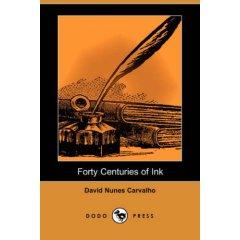| 2020ok Directory of FREE Online Books and FREE eBooks |
Free eBooks > Science > History & Philosophy > History of Science > Forty Centuries Of Ink
Forty Centuries Of Inkby David Nunes Carvalho  Download Book (Respecting the intellectual property of others is utmost important to us, we make every effort to make sure we only link to legitimate sites, such as those sites owned by authors and publishers. If you have any questions about these links, please contact us.) link 1 link 2 About Book Book Description It all started forty centuries ago: the genesis of Ink. Download Description History has not given us the names of ancient ink makers; but we can believe there must have been during a period of thousands of years a great many, and that the kinds and varieties of inks were without number. Those inks which remain to us are to be found only as written with on ancient MSS.; they are of but few kinds, and in composition and appearance preserve a phenomenal identity, though belonging to countries and epochs widely separated. Excerpted from Forty Centuries of Ink [E-BOOK: MICROSOFT READER] by David N. Carvalho. Copyright © 2000. Reprinted by permission. All rights reserved ...The Hebrew word for ink is deyo, so called from its blackness. As primitively prepared for ritualistic purposes and for a continuing period of more than two thousand years, it was a simple mixture of powdered charcoal or soot with water, to which gum was sometimes added. The Arabian methods of making ink (alchiber) were more complex. Lampblack was first made by the burning of oil, tar or rosin, which was then commingled with gum and honey and pressed into small wafers or cakes, to which water could be added when wanted for use. About 1200 years before the Christian era, the Chinese perfected this method and invented “Indian Ink,” ostensibly for blackening the surface of raised hieroglyphics, which “was obtained from the soot produced by the smoke of pines and the oil in lamps, mixed with the isinglass (gelatin) of asses’ skin, and musk to correct the odour of the oil.” Du Halde cites the following, as of the time of the celebrated Emperor Wu-Wong, who flourished 1120 years before Christ: “As the stone Me (a word signifying blackening in the Chinese language), which is used to blacken the engraved characters, can never become white; so a heart blackened by vices will always retain its blackness.” That the art of dyeing was known, valued and applied among early nations, is abundantly clear. The allusions to “purple and fine raiment,” to “dyed garments,” to “cloth of many colours,” &c., are numerous in the Bible. In a note to the “Pictorial Bible, after an allusion to the antiquity of this art, and to the pre-eminence attached by the ancients to purple beyond every other color, it is remarked: “It is important to understand that the word purple, in ancient writings, does not denote one particular colour.” Related Free eBooks
| Related Tags |












SEND A COMMENT
PLEASE READ: All comments must be approved before appearing in the thread; time and space constraints prevent all comments from appearing. We will only approve comments that are directly related to the article, use appropriate language and are not attacking the comments of others.